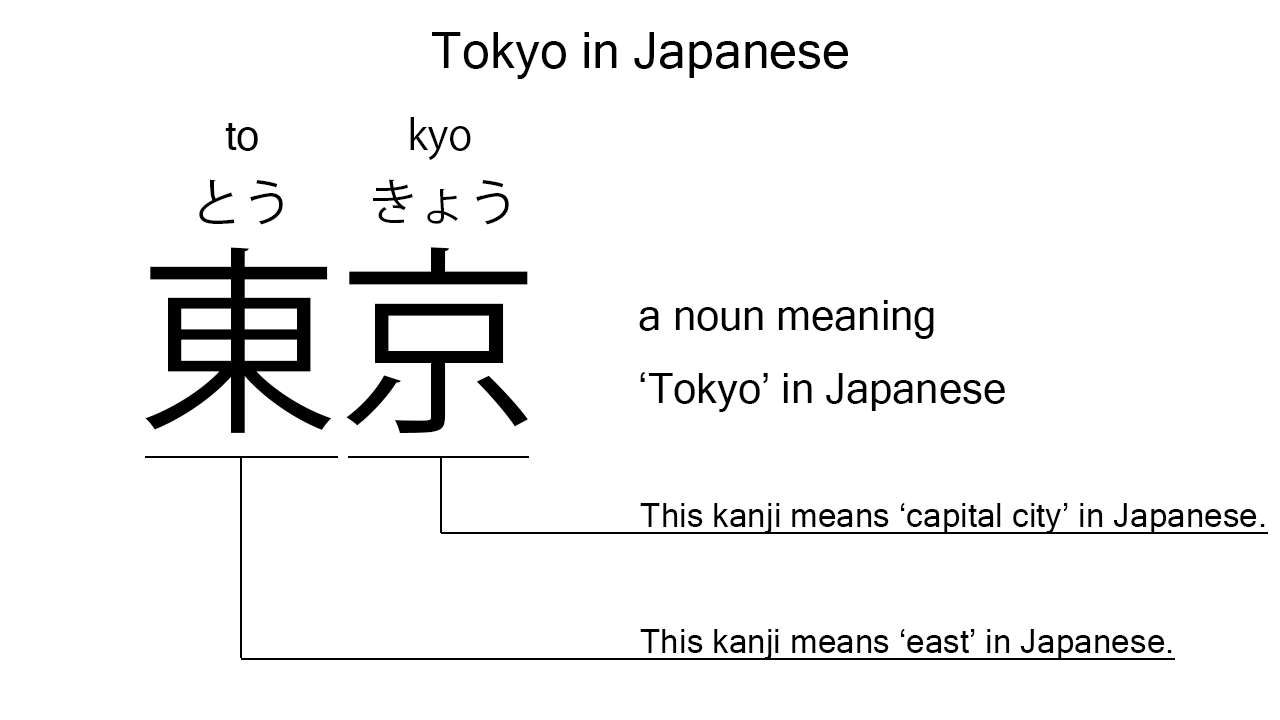What does “tokyo” mean in Japanese?
Probably, many Japanese learners know the name of the capital of Japan: Tokyo. Most of them, however, do not know what it really means in Japanese. In this blog post, therefore, I will explain this name in detail based on its kanji expression. And also, I will explain how to use it through an example sentence. My explanations would help Japanese learners understand the capital of Japan more clearly. Then, let’s get started!
Contents
Definition and meaning of “tokyo”
Let me start with the definition and meaning of tokyo.
- tokyo – 東京 (とうきょう) : a noun meaning ‘Tokyo’ in Japanese. This is the name of the capital of Japan.
The definition and meaning are very simple and clear. To understand this noun more clearly, however, let me explain its kanji characters in detail, one by one.
Tokyo in kanji
The kanji expression of tokyo consists of the following two characters:
- 東 : a kanji character used to mean ‘east’ in Japanese.
- 京 : a kanji character used to mean ‘the capital city’ in Japanese.
From these two kanji characters, we can understand that the formed noun literally means ‘the east capital city’ in Japanese. This kanji concept represents really well what the Japanese capital city is. It is located on the east side of Japan and widely considered as the capital city. The first kanji character meaning ‘east’ is used to differentiate Tokyo from the former capital city, Kyoto, which is located at more or less the center of Japan. Interestingly, both kanji characters used in Kyoto mean ‘the capital city’ in Japanese. It was the first official capital city of Japan, so no directional word was necessary in the name. We should know the relation between these two city names, I think.

When we meet new kanji expressions, we should check their kanji characters in detail to understand their meanings clearly and deeply. In many cases, kanji characters tell us a lot about the meanings of the expressions they form. Actually, here, we could get the better understanding of tokyo through the detailed check above.
So far, I’ve explained the definition and meaning of tokyo together with its kanji characters. Then, let me explain how to use it through the example sentence below.
Example of “tokyo”
boku tachi wa ashita tokyo ni iki masu – 僕達は明日東京に行きます (ぼくたちはあしたとうきょうにいきます)
We will go to Tokyo tomorrow.
Below are the new words used in the example sentence.
- boku – 僕 (ぼく) : a pronoun meaning ‘I’ in Japanese. This is used mainly by boys and young males.
- tachi – 達 (たち) : a suffix used after a noun or pronoun to make its plural form. In the example, this is used after boku to make its plural form, boku tachi, which means ‘we’ in Japanese. Learn more about Japanese plural.
- wa – は : a binding particle working as a case marker or topic marker. In the example, this works after boku tachi to make the subject in the sentence.
- ashita – 明日 (あした) : a noun meaning ‘tomorrow’ in Japanese. This can also work as an adverb almost anywhere in a sentence. In the example, this works as an adverb in the middle of the sentence to mean ‘tomorrow’ in Japanese.
- ni – に : a case particle used to say where someone or something goes. In the example, this is used after tokyo to say where the speakers will go tomorrow.
- iki – 行き (いき) : one conjugation of the verb, iku, which means ‘to go’ in Japanese. In the example, it has been conjugated for the better connection with its following word.
- masu – ます : an auxiliary verb used after a verb to make it polite. Probably, this is well known as a part of Japanese masu form. In the example, this is used after iki to make it sound polite.
This is a typical usage of tokyo. In the example, it works together with the case particle, ni, to say where the speakers will go tomorrow. This combination is sometimes used in Japanese conversations, so it’s worth knowing.
Summary
In this blog post, I’ve explained the definition and meaning of tokyo in detail based on its kanji expression. And also, I’ve explained how to use it through the example sentence. Let me summarize them as follows.
- tokyo – 東京 (とうきょう) : a noun meaning ‘Tokyo’ in Japanese. This is the name of the capital of Japan. These two kanji characters mean ‘east’ and ‘the capital city’ respectively. So, this noun literally means ‘the east capital city’ in Japanese. This kanji concept represents really well what the Japanese capital city is. It is located on the east side of Japan and widely considered as the capital city.
Hope my explanations are understandable and helpful for Japanese learners.
Leave a Reply